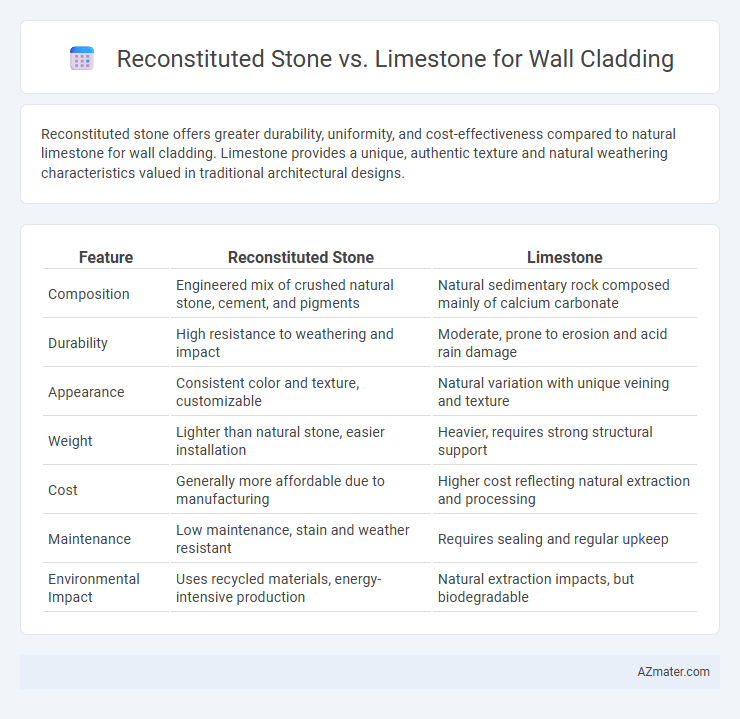Reconstituted stone offers greater durability, uniformity, and cost-effectiveness compared to natural limestone for wall cladding. Limestone provides a unique, authentic texture and natural weathering characteristics valued in traditional architectural designs.
Table of Comparison
| Feature | Reconstituted Stone | Limestone |
|---|---|---|
| Composition | Engineered mix of crushed natural stone, cement, and pigments | Natural sedimentary rock composed mainly of calcium carbonate |
| Durability | High resistance to weathering and impact | Moderate, prone to erosion and acid rain damage |
| Appearance | Consistent color and texture, customizable | Natural variation with unique veining and texture |
| Weight | Lighter than natural stone, easier installation | Heavier, requires strong structural support |
| Cost | Generally more affordable due to manufacturing | Higher cost reflecting natural extraction and processing |
| Maintenance | Low maintenance, stain and weather resistant | Requires sealing and regular upkeep |
| Environmental Impact | Uses recycled materials, energy-intensive production | Natural extraction impacts, but biodegradable |
Introduction to Wall Cladding Materials
Wall cladding materials, including reconstituted stone and limestone, play a crucial role in both aesthetic appeal and structural protection for buildings. Reconstituted stone, engineered from crushed natural stone and binder, offers uniformity, durability, and cost-effectiveness, while limestone provides natural beauty and weather resistance due to its sedimentary composition. Selecting the appropriate material depends on factors such as climate, maintenance requirements, budget, and desired architectural style.
What is Reconstituted Stone?
Reconstituted stone is an engineered material made from crushed natural stone mixed with cement, pigments, and other additives to create durable, uniform slabs for wall cladding. It offers greater consistency in color and texture compared to natural limestone, while maintaining a similar aesthetic appeal. Unlike traditional limestone, reconstituted stone is more resistant to weathering and can be tailored to specific architectural requirements.
Understanding Natural Limestone
Natural limestone features a porous texture and varying fossil patterns, making it highly breathable and ideal for wall cladding applications requiring moisture regulation. Its high calcium carbonate content contributes to durability while maintaining natural aesthetic appeal through unique color variations. Unlike reconstituted stone, limestone offers authentic geological characteristics and environmental benefits with sustainable quarrying practices.
Aesthetic Differences: Texture and Color
Reconstituted stone offers consistent texture and uniform color options due to its manufactured process, allowing for precise replication of natural stone patterns in wall cladding. Limestone, characterized by its naturally occurring irregularities and subtle color variations, provides a unique, organic aesthetic that enhances architectural depth and authenticity. The choice between the two impacts wall cladding's visual appeal, with reconstituted stone providing controlled design flexibility and limestone delivering natural elegance.
Durability and Longevity
Reconstituted stone offers enhanced durability and longevity compared to natural limestone due to its engineered composition, which resists weathering, erosion, and staining more effectively. Limestone, while aesthetically pleasing and naturally durable, is more porous and susceptible to acid rain and environmental wear, leading to potential surface degradation over time. For wall cladding, reconstituted stone provides a longer-lasting, low-maintenance solution ideal for harsh climates or high-traffic areas.
Installation Process Comparison
Reconstituted stone offers a more uniform size and shape, enabling faster and easier installation compared to natural limestone, which often requires skilled labor to handle its irregularities and weight. The consistent density of reconstituted stone allows for simpler cutting and fitting on wall surfaces, reducing overall labor time and cost. Limestone installation demands careful alignment and anchoring due to its natural variance and porosity, often requiring additional sealing to prevent moisture absorption.
Maintenance Requirements
Reconstituted stone offers lower maintenance requirements compared to natural limestone due to its enhanced resistance to weathering, staining, and moss growth. Limestone requires regular sealing and cleaning to prevent surface erosion and discoloration caused by moisture and environmental pollutants. Choosing reconstituted stone for wall cladding minimizes long-term upkeep costs while maintaining aesthetic durability in various climates.
Cost Analysis: Reconstituted Stone vs Limestone
Reconstituted stone offers a cost-effective alternative to natural limestone for wall cladding, typically priced 30-50% lower due to its man-made composition and easier manufacturing process. Limestone, while more expensive upfront, provides superior durability and natural aesthetic value, which can potentially reduce long-term maintenance costs. Evaluating overall project budgets, including installation and upkeep, often reveals reconstituted stone as the more budget-friendly option without significant compromise on appearance.
Environmental Impact and Sustainability
Reconstituted stone for wall cladding offers a sustainable alternative by utilizing recycled materials and reducing the demand for natural quarrying, thus lowering the environmental footprint associated with raw limestone extraction. Limestone, while natural and durable, involves significant habitat disruption, energy consumption, and carbon emissions during mining and processing. Choosing reconstituted stone helps conserve natural resources and supports eco-friendly construction practices through enhanced recyclability and reduced waste generation.
Choosing the Right Material for Your Project
Reconstituted stone offers consistent texture and color, making it ideal for projects requiring uniformity and durability in wall cladding, while limestone provides natural beauty with unique veining and weathering patterns that enhance aesthetic appeal. Consider environmental factors such as exposure to moisture and temperature fluctuations, as reconstituted stone typically resists weathering better than porous limestone. Budget constraints and maintenance requirements also influence the decision, with reconstituted stone often presenting a cost-effective, low-maintenance solution compared to the higher upkeep of natural limestone.

Infographic: Reconstituted stone vs Limestone for Wall Cladding
 azmater.com
azmater.com